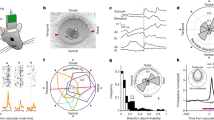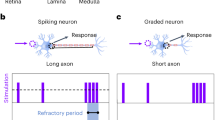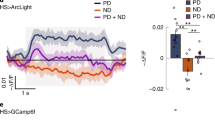Abstract
HUMANS, animals and some mobile robots use visual motion cues for object detection and navigation in structured surroundings1–4. Motion is commonly sensed by large arrays of small field movement detectors, each preferring motion in a particular direction5,6. Self-motion generates distinct 'optic flow fields' in the eyes that depend on the type and direction of the momentary locomotion (rotation, translation) 7. To investigate how the optic flow is processed at the neuronal level, we recorded intracellularly from identified interneurons in the third visual neuropile of the blowfly8. The distribution of local motion tuning over their huge receptive fields was mapped in detail. The global structure of the resulting 'motion response fields' is remarkably similar to optic flow fields. Thus, the organization of the receptive fields of the so-called VS neurons9,10 strongly suggests that each of these neurons specifically extracts the rotatory component of the optic flow around a particular horizontal axis. Other neurons are probably adapted to extract translatory flow components. This study shows how complex visual discrimination can be achieved by task-oriented preprocessing in single neurons.
This is a preview of subscription content, access via your institution
Access options
Subscribe to this journal
Receive 51 print issues and online access
$199.00 per year
only $3.90 per issue
Buy this article
- Purchase on Springer Link
- Instant access to full article PDF
Prices may be subject to local taxes which are calculated during checkout
Similar content being viewed by others
References
Nakayama, K. Vision Res. 25, 625–660 (1985).
Wehner, R. in Handbook of Sensory Phsyiology Vol. VII/6C (ed. Autrum, H.) 287–616 (Springer, Berlin, 1981).
Warren, W. H. & Hannon, D. J. Nature 336, 162–163 (1988).
Franceschini, N., Pichon, J. M. & Blanes, C. Phil. Trans. R. Soc. Lond. B 337, 283–294 (1992).
Borst, A. & Egelhaaf, M. in Visual Motion and its Role in the Stabilization of Gaze (eds Miles, F. A. & Wallman, J.) 3–27 (Elsevier, Amsterdam, 1993).
Reichardt, W. J. Comp. Physiol. A 161, 533–547 (1987).
Gibson, J. J. The Perception of the Visual World (Houghton Mifflin, Boston, 1950).
Hausen, K. in Visual Motion and its Role in the Stabilization of Gaze (eds Miles, F. A. & Wallman, J.) 203–235 (Elsevier, Amsterdam, 1993).
Hengstenberg, R., Hausen, K. & Hengstenberg, B. J. Comp. Physiol. A 149, 163–177 (1982).
Hengstenberg, R. J. Comp. Physiol. A 149, 179–193 (1982).
Nakayama, K. & Loomis, J. M. Perception 3, 63–80 (1974).
Koenderink, J. J. & van Doorn, A. J. Biol. Cybern. 56, 247–254 (1987).
Tanaka, K. & Saito, H.-A. J. Neurophysiol. 62, 626–641 (1989).
Duffy, C. J. & Wurtz, R. H. J. Neurophysiol. 65, 1329–1345 (1991).
Collett, T. S., Nalbach, H.-O. & Wagner, H. in Visual Motion and its Role in the Stabilization of Gaze (eds Miles, F. A. & Wallman, J.) 239–263 (Elsevier, Amsterdam, 1993).
Morrone, M. C., Burr, D. C. & Vaina, L. M. Nature 376, 507–509 (1995).
Götz, K. G., Hengstenberg, B. & Biesinger, R. Biol. Cybern. 35, 101–112 (1979).
Borst, A. & Egelhaaf, M. Proc. Natl Acad. Sci. USA 89, 4139–4143 (1992).
Geiger, G. & Nässel, D. R. Nature 293, 398–399 (1981).
Pflugfelder, G.-O. & Heisenberg, M. Comp. Biochem. Physiol. A 110, 185–202 (1995).
Hausen, K. & Wehrhahn, C. Proc. R. Soc. Lond. B 219, 211–216 (1983).
Hengstenberg, R. Neuroscience 3, 19–29 (1991).
Krapp, H. G. & Hengstenberg, R. Vision Res. (in the press).
Hengstenberg, R., Bülthoff, H. & Hengstenberg, B. in Functional Neuroanatomy (ed. Strausfeld, N. J.) 183–205 (Springer, Berlin, 1983).
Hengstenberg, R. in Proc. 4th Int. Congr. of Neuroethology (eds Burrows, M., Matheson, T., Newland, P. L. & Schuppe, H.) 255 (Thieme, Stuttgart, 1995).
Srinivasan, M. V., Jin, Z. F., Stange, G. & Ibbotson, M. R. Biol. Cybern. 68, 199–207 (1993).
Krapp, H. thesis, Univ. Tübingen (1995).
Krapp, H. & Hengstenberg, R. in Proc. 4th Int. Congr. of Neuroethology (eds Burrows, M., Matheson, T., Newland, P. L. & Schuppe, H.) 264 (Thieme, Stuttgart, 1995).
Egelhaaf, M., Borst, A. & Reichardt, W. J. Opt. Soc. Am. A 6, 1070–1087 (1989).
Strausfeld, N. J., Seyan, H. S., Wohlers, D. & Bacon, J. P. in Functional Neuroanatomy (ed Strausfeld, N. J.) 132–155 (Springer, Berlin, 1983).
Author information
Authors and Affiliations
Rights and permissions
About this article
Cite this article
Krapp, H., Hengstenberg, R. Estimation of self-motion by optic flow processing in single visual interneurons. Nature 384, 463–466 (1996). https://doi.org/10.1038/384463a0
Received:
Accepted:
Issue Date:
DOI: https://doi.org/10.1038/384463a0
This article is cited by
-
Motor neurons generate pose-targeted movements via proprioceptive sculpting
Nature (2024)
-
The role of vision in sensory integration models for predicting motion perception and sickness
Experimental Brain Research (2024)
-
Model organisms and systems in neuroethology: one hundred years of history and a look into the future
Journal of Comparative Physiology A (2024)
-
Multilevel visual motion opponency in Drosophila
Nature Neuroscience (2023)
-
Impact of walking speed and motion adaptation on optokinetic nystagmus-like head movements in the blowfly Calliphora
Scientific Reports (2022)
Comments
By submitting a comment you agree to abide by our Terms and Community Guidelines. If you find something abusive or that does not comply with our terms or guidelines please flag it as inappropriate.



